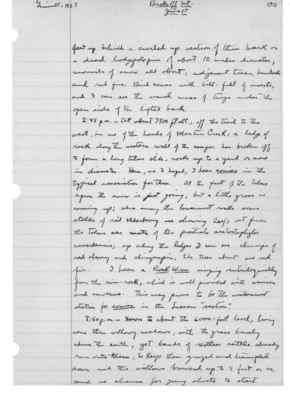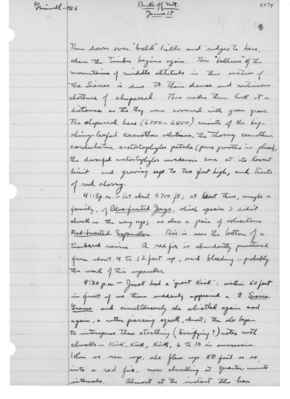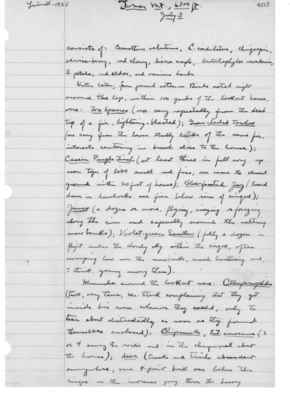Pages That Mention red cherry
1925: Joseph Grinnell's field notes
S2 Page 18
Collector: Grinnell - 1925 Location: Lassen Section (Brokeoff Mt.) Date: June 17, 1925 Page Number: 2471
feet up behind a curled up section of thin bark on a dead lodgepole pine of about 10 inches diameter; mounds of snow all about; adjacent trees, hemlocks and red firs. Bird comes with bill-full of insects, and I can see the usual mass of twigs under the open side of the lifted park. 2:45 p.m. - At about 7500 ft. alt.; off the trail to the west, in one of the heads of Martin Creek; a ledge of rock along the western wall of the canyon has broken off to form a long talus slide, rocks up to a yard or more in diameter. Here, as I hoped, I hear conies in the typical association for them. At the fast of the Talus apron the snow is just going, but a little grass is coming up; also among the lowermost rocks some stalks of red elderberry are showing leaf; out from the Talus are mats of the prostrate arctostaphylos nevadensis; up along the ledges I can see clumps of red cherry and chinquapin; the trees about are red fir. I hear a Rock Wren singing ventriloquially from the rim-rock, which is well provided with crevices and caverns. This may prove to be the westernmost station for conies in the Lassen "section." 3:50 p.m. - Down to about 600-foot level, having come thru willowy meadows, with the grass barely above the earth, yet bands of restless cattle already run onto them, to keep them grazed and trampled down and the willows browsed up to 5 feet or so, and no chance for young shoots to start.
S2 Page 19
Collector: Grinnell - 1925 Location: Lassen Section (Brokeoff Mt.) Date: June 17, 1925 Page Number: 2474
Then down over "bald" hills and ridges to here, where the Timber begins again. This "baldness" of the mountains of middle altitude in this section of the Sierras is due to their dense and continuous clothure of chaparral. This makes them look at a distance as tho they were covered with green grass. The chaparral here (6000-6500) consists of the big shiny-leafed ceanothus velutinus, the thorny ceanothus condulatus, arctostaphylos patula (pure growths in places), the dwarfed arctostaphylos nevadensis here at its lowest limit and growing up to two feet high, and tracts of red cherry. 4:15 p.m. - At about 6700 ft.; at least there, maybe a family, of Blue-fronted Jays, which species I didn't check on the way up; as also a pair of solicitous Red-breasted Sapsuckers. This is near the bottom of a timbered ravine. A red fir is abundantly punctured from about 4 to 12 feet up, and bleeding - probably the work of this sapsucker. 4:30 p.m. - Just had a "great kick": within 50 feet in front of us there suddenly appeared a female Sierra Grouse and simultaneously she whistled again and again, a rather piercing squall, almost; then she began to intersperse these startling (terrifying?) notes with clucks - kirk, kirk, kirk, 6 to 10 in succession. When we ran up, she flew up 80 feet or so into a red fir, now clucking at quarter-minute intervals. Almost at the instant the hen
S2 Page 37
Collector: Grinnell - 1925 Location: Mineral Date: June 22 Page Number: 2491
Wright Flycatcher's nest, near camp (75 ft. uphill from), with 4 young hatched on 14th; found with opaque eggs two days previously by Dixon and, I think, photographed by him. Rim of nest 1500 mm. above ground, nest (of usual construction and gray color, ensconced among pendent twigs were [sic] a slender branch from each of two adjacent red cherry bushes one another, and one of these has an unhealthy outgrowth of leafage looking like mistletoe. Nest within to feet, one east side, of 24-inch trunk of yellow pine; snow bushes nearby, and firs within 20 feet; site practically where a tract of timber and a hillside tract of open snowbush adjoins. Male fed young at 3:12 and 3:16, he not being, apparently, alarmed at us, as is female which was brooding when we came. Female continues to utter a faint "peet" of concern; male from overhead says "see-put" (uttered very rapidly); when male alighted on edge of nest to feed, he gave a short musical trill of short duration and weak in volume. Female keeps close to nest, perching on twigs within a radius of 4 feet. She perches on edge of nest; leaves; returns and settles down to brood, continuing to say "peet", but more faintly. 3:30 - [female symbol] still brooding and saying "peet" very faintly and not so frequently. 3:35 - (female) still brooding, tho nest is in shade of pine trunk: has ceased to say "pit."
S2 Page 64
Collector: Grinnell - 1925 Location: Turner Mt., 6300 ft. Date: July 3 Page Number: 2517
consist of: Ceanothus velutinus, C. cordulatus, chinquapin, service-berry, red cherry, Sierra maple, Arctostaphylos nevadensis, A. patula, red alder, and various herbs.
Written later, from pencil notes. - Birds noted right around the top, within 100 yards of the lookout house, were: Fox Sparrow (one sang repeatedly from the dead tip of a fir, lightning-blasted); Green-tailed Towhee (one sang from the lower stubby limbs of the same fir, interests centering in the brush close to the house); Cassin Purple Finch (at least three in full song up near tops of live small red firs, one came to cleared ground within 20 feet of house); Blue-fronted Jay (heard down in the hemlocks and firs below rim of cirque); Junco (a dozen or more, flying, singing or foraging along the rim and especially around the melting snow banks); Violet-green Swallow (fully a dozen in flight under the cloudy sky within the cirque, often swooping low over the snowbanks, much twittering and, I think, young among them.
Mammals around the lookout were: Callospermophilus (two, very tame, Mr. Stark complaining that they got inside his room whenever they could, only to tear about distractedly as soon a they found themselves enclosed), Chipmunks, Eut. amoenus (3 or 4 among the rocks and in the chaparral about the house); deer (tracks and tails abundant everywhere, one 4-point buck seen below the cirque on the moraines going thru [sic] the heavy



